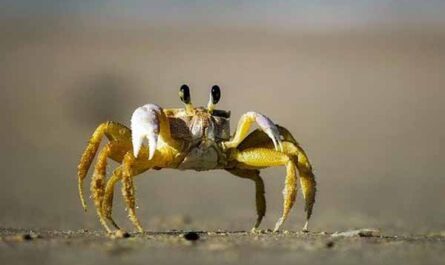The fishing cat is perhaps the only type of cat, which has a strong attachment to water, as it eats mostly fish.
The animal sits in an ambush on the shore, and when fishing cat comes close to it – jumps into the water and with one precise hit of a clawed paw throws it ashore. Today we will tell you amazing facts about fishing cats.
Distribution of fishing cats
This unusual animal is also called: a fisherman, and Asian fish cat. This cat is common in Sri Lanka, along the coast of South and Southeast Asia as far as Malacca and Sumatra; the smallest representatives of the species live in Java and Bali. Fishing cat – inhabit the wet jungle up to 1500 meters above sea level, mangrove coastal swamps near rivers and streams.
The appearance of fishing cats
Fishing cats have a strong muscular body 95-120 cm long, short legs; large rounded head with strong jaws. The neck of a cat fisherman is also short, the ears are rounded, small, low on the sides of the head; the tail is not long (26-36 cm) and thick at the base. Females in this predator are smaller than males, they weigh only 6-7 kg (the weight of a male can reach 11-15 kg.) The fur of a fishing cat is short and rough, painted in olive-brown or olive-gray color, which makes it almost invisible in thickets. It is amazing that on its front paws, between its fingers, this cat has membranes that do not allow large and sharp claws to retract but help fishing in the water.
Lifestyle and nutrition of fishing cats
Fishing cats can climb trees, but does it very rarely. Most often it can be seen walking in shallow water. It swims perfectly and uses its short tail as a steering wheel. The fishing cat is a single animal; each individual has its territory. As the name implies, this predator’s favorite food is fish. It catches it in the light of day, and at dusk and night, it can hunt for other prey. During fishing, the fishing cat sits on the bank of a stream or river and waits, but as soon as he notices the fish, he abruptly hits the prey with his clawed paw. It also hunts toads, frogs, crustaceans, snakes, small mammals, and birds, sometimes even attacks poultry, dogs, goats, and calves.
Reproduction of fishing cats
Fishing cats breed all year round. 2-3 blind kittens female gives birth in a den, which is arranged in thickets of cane or bush, natural caves, in hollow trees. The eyes of the cubs open for 15 days, the mother feeds them with milk for up to 3 months and then begins to feed them meat. Kittens grow up by the age of 9 months. Male of fishing cats, contained in captivity, help the female to take care of her kittens, but it is not known exactly how they behave in nature.
Nature conservation status of fishing cats
Caught at a young age, fishing cats are well tamed and attached to people. However, the local population persecutes those cats that steal their poultry and devastate their fish stocks. Also, meat and hides of fishing cats are used by aborigines in folk medicine to prepare medicines. The fishing cat is a rare animal, listed in the IUCN Red List.
Subspecies of fishing cats
- Prionailurus viverrinus risophores
- Prionailurus viverrinus viverrinus
Did you like amazing facts about fishing cats? Share it with your friends.
Fishing Cat Facts
A little about the Fishing Cat is worth knowing. These large cats are not very common in the wild, preferring inhospitable habitats. But they once inhabited many regions of southern Asia, including India, Sri Lanka, Myanmar, Thailand, and Malaysia. Their diets are primarily crayfish and frogs, but they also feed on rodents, snakes, rabbits, and carrion. Here are some fun facts about the Fishing Cat.
The Fishing Cat has an unusual coat pattern that makes it appear camouflaged in the water. The stripes and spots that make it look so distinctive are black. They are characterized by six to eight black lines that run from the forehead to the neck, and two shorter bars on the shoulders. Their eyes are ringed in white fur, and their ears are short and round with a characteristic white spot in the center. Its long and webbed claws are a striking feature.
The Fishing Cat’s short tail has a few rings at the tip. Its claws are not completely sheathed and extend slightly when retracted. The layered fur of the Fishing Cat serves as insulation and water-proofing. It has long guard hairs that protrude from the coat. Its color varies from tan to ash grey and has a narrow or broad coat. This type of fur is prone to a raccoon-like appearance, making it an attractive choice for those interested in nature.
The tail is small and pointed, and the claw tips are not fully retracted. The fishing cat’s claws are only partially sheathed, and the tips stick out when they are retracted. They have a thick coat of fur and large, thick paws. It has two rows of spots on its throat. The male fishing cat weighs between 8.5 and 16 kilograms, while the female is less than half that. It has a wide, whitetail and a pale belly, and has long slender ears.
A fisherman’s cat’s life span is approximately 15 years, but he or she might only live for about a dozen more. However, the fishing cat’s unique coat structure makes it a unique species among cats and is a valuable asset in both the wild and in captivity. This is a fascinating animal and deserves some research. This article will give you some great fishing cat facts. But it’s not the only one you should read!
The Fishing Cat is a medium-sized cat that is native to South and Southeast Asia. It is more than twice the size of domestic cats and is a member of the viridae family. Its body length varies from 57 to 78 centimeters, and its tail is about 20 to 30 centimeters long. Despite being a small cat, it stands at around 40 cm (16 inches) tall and weighs five to sixteen kilograms.
The Fishing Cat is the only cat that lives near water. In fact, it is the only feline species that live in water. Its habitat includes lakes, rivers, and even ponds. In the wild, the Fishing Cat is largely nocturnal and lives in wetlands and swamps. Its name derives from the fact that it is an omnivorous cat, which means it can live in water.
The Fishing Cat has a surprisingly unique fur structure. This species has a dense layer of fur that lies against its skin. These coats are made up of tightly-packed strands of hair. This dense layer prevents water from reaching the cat’s skin and is therefore warm even in chilly water. The fishing cat is also known to attack adult cattle and dogs. Sadly, the population of this feline is declining.
The Fishing Cat has a short lifespan and lives between fifteen and twenty-five years in captivity. The fish in its mouth are attracted to the tapping of the water surface, which it then scoops up with its paw. It is also known to hunt ducks, frogs, snakes, and crabs. Its name is derived from the Latin word “fisherman”, which means “fishing cat”.








